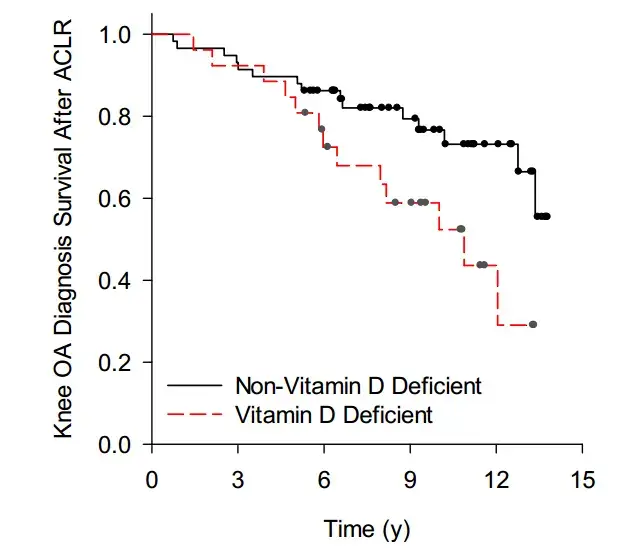ACL Knee surgery increases risk of subsequent Knee Osteoarthritis by up to 2X (both low D)
Observation: Higher level of Vitamin D should:
1) Decrease ACL tear incidence
2) Speedup recovery from ACL surgery
3) Slowup the incidence of Knee Osteoarthritis
Vitamin D Deficiency after Anterior Cruciate Ligament Reconstruction Associates with Knee Osteoarthritis: A Retrospective Study
Nutrients. 2024 Sep 8;16(17):3029. doi: 10.3390/nu16173029.
Sonu Bae 1, Laura C Schmitt 1 2, Zachary Burnett 3, Eric M Milliron 3, Parker A Cavendish 3, Robert A Magnussen 1 3, Christopher C Kaeding 1 3, David C Flanigan 1 3, Tyler Barker 1 4

Background/objectives: The objective of this study was to test the hypothesis that vitamin D deficiency (i.e., serum 25-hydroxyvitamin D (25(OH)D) ≤ 20 ng/mL) associates with the increased occurrence and shortened time to a knee osteoarthritis (OA) diagnosis after anterior cruciate ligament reconstruction (ACLR).
Methods: This study consisted of a retrospective, case-control design. The inclusion criteria consisted of (1) patients (≥18 y) who underwent arthroscopic ACLR with (cases; n = 28) and without (controls; n = 56) a subsequent knee OA diagnosis (≥90 d from the date of ACLR) and (2) with a documented serum 25(OH)D concentration after ACLR (and before a knee OA diagnosis for the cases). Controls were matched (2:1) to cases based on sex, age at ACLR, date of ACLR, and body mass index. After matching, patients were separated into two groups: (1) vitamin D deficient (serum 25(OH)D ≤ 20 ng/mL) or (2) non-vitamin D deficient (serum 25(OH)D > 20 ng/mL). Data were extracted from the medical records.
Results: Thirty-one percent (n = 26) of patients included were vitamin D deficient. Fifty percent (n = 13) of the vitamin D deficient and twenty-six percent (n = 15) of the non-vitamin D deficient patients were subsequently diagnosed with knee OA (p = 0.03). Time from ACLR to a knee OA diagnosis was significantly (p = 0.02) decreased in the vitamin D deficient (OA-free interval, 95% confidence interval [CI] = 7.9 to 10.9 y) compared to the non-vitamin D deficient group (OA-free interval, 95% CI = 10.5 to 12.5 y).
Conclusions: Vitamin D deficiency after ACLR may serve as a prognostic biomarker for knee OA following ACLR.
📄 Download the PDF from VitaminDWiki
VitaminDWiki - ACL knee problems assocated with low Vitamin D - several studies
28+ VitaminDWiki pages with KNEE OSTEOARTHRITIS in title
This list is automatically updated
{LIST()}
